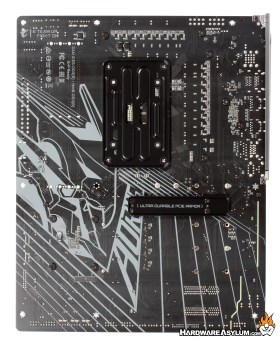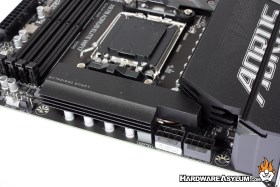Aorus X870 Elite WiFi 7 Motherboard Review
Author: Dennis GarciaBoard Layout and Features
The X870 Aorus Elite motherboard seems to be following the new standard when it comes to gaming ready motherboard designs, which can be seen in the PCI Express layout. At the top you will find a single PCI Express 16x slot with a white center, at the very bottom of the motherboard you will find two more full length slots. As you can expect, this layout goes a long way in maximizes drive storage while still offering some PCI Express slot expansion for those users wanting a little more.
In terms of overall design, I am impressed with how the decorative lines merge to create a flowing pattern from the I/O cover to the PCB and down across the M.2 and MCP heatsinks. There is a strange gap with the logo on the I/O cover but the rest of the lines are nicely laid out.
Looking at the back of the motherboard can tell you a lot about how any particular board is constructed. Typically, you’ll see things like how the PCI Express slots are wired up and where the major components are located. With the advent of PCI Express 5.0 many board makers have started to use surface mount expansion slots in an attempt to reduce EMI.
At the bottom of the motherboard, you will find the two expansion slots wired to 4x while the actual slot is a full 16x. In addition, you will find the large backplate for the AM5 socket along with the Ultra Durable PCIE Armor. This backplate works in conjunction with the Ultra Durable Slot X slot cover on the front side of the motherboard. This solid metal bracket helps to reinforce the PCI Express slot and prevent it from breaking and pulling away from the PCB due to heavy and oversized video cards.
Maybe what stands out the most is the huge AORUS graphic that has been screened over the entire PCB and how it obscures the back drilled memory traces giving the back of the PCB an extremely smooth finish. Back drilling the memory traces is something that was introduced with the Z790 X series refresh boards and is how Aorus motherboards can relocate the memory signal traces to the middle of the PCB and considerably reduce memory interference.
The CPU socket is rather typical for the AM5 platform. Across the top and bottom of the socket you’ll find the heatsink retention brackets and almost always get removed when installing an aftermarket heatsink. What is nice about this configuration is that the backplate remains allowing you to secure everything into a factory part that is extremely strong.
The CPU VRM is a Digital twin 16+2+2 design with a total of 20 VRM power phases powering the AM5 CPU socket and supporting hardware.
CPU power is delivered by two dedicated 8-pin power sockets located behind the large VRM cooler. While access is tight there is still plenty of room to connect and remove the required cables.







